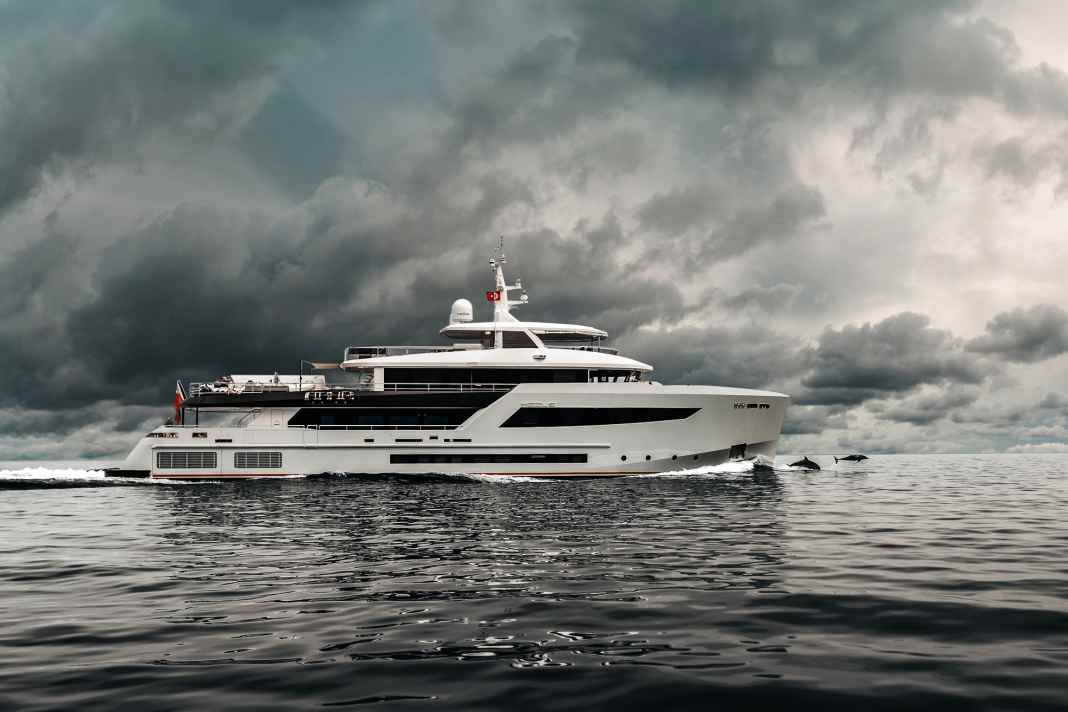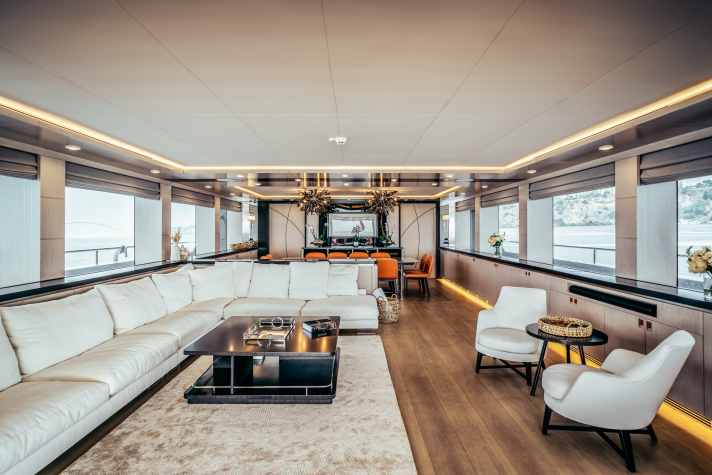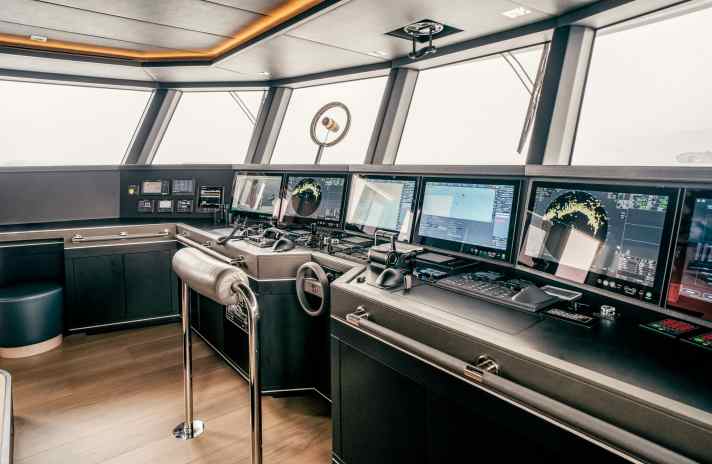





It's cold. No, not air-conditioning-cool. Not even if you take the US standards for summer room temperature control as a basis. It's not a cold store either, at least not for food. There are lithium-ion batteries here, on shelves in five rows of five stacks each. This results in a capacity of 550 kilowatt hours and the option for fully electric driving, as Bogdan Gusarev reports at the start of the tour. The Corvus batteries are wired and constantly monitored. The hybrid drive system is the reason why the delivery of the Bering flagship was delayed. The first 145 was another challenge: the largest yacht in the shipyard's history. It went from 80 to 145 feet.
A 55 and 58 metre format from two large shipyards are also moored at the pier of Antalya's free trade zone, which is used by all the local shipyards. "Heeus" may only measure 44.20 metres from the tip of the stem to the stern platform, but its width of 9.70 metres still makes it stand out. This makes her the prime example of a length segment in which the decks of semi-planing vessels typically span just over eight metres; displacement vessels that are considered wide come in at just over nine metres. Despite the overhanging steel hull, the result is a volume of less than 499 gross tonnes. This magical cubature mark was achieved with the help of the usual tricks: an airy sun deck here, a beach club there, which becomes an outdoor area via louvres in the hull.
The "Heeus" comes with flatter lines
With the raised bow, the ice ring along the waterline, the mouse-grey paintwork and the tenders aft on the upper deck, everything screams Explorer, and yet "Heeus" also marks a turning point for Bering in terms of exterior design. The lines are much flatter and finer than those of the compact explorers and yet again originate from Australian designer Scott Blee, who has offices in Melbourne and Hobart with Sabdes Superyacht Design. Blee may be physically far away from the planet's superyacht hotspots, but somehow a design outpost in Tasmania suits this shipyard with a remarkable history and its Russian-American founder (shipyard report from page 150).
Another milestone for Bering is the quality and variety of the interior fittings, which were carried out in-house. Bogdan Gusarev, who represents Bering in Europe from Düsseldorf, invites us into the saloon: "Here we have a ceiling height of 2.35 metres. The same as on the Bering 80." In front of the dining table is a unit consisting of four wine fridges, behind which a hatch in the floor is clearly visible. The practical details cannot be completely concealed. Anything else would not suit Bering either; after all, a large storage volume is a fundamental component of the self-sufficiency that is so important to Explorer.
Discreet interior with orange accents
The dining chairs, which are manufactured in-house, catch the eye with their bright orange covers made from Foglizzo leather. Gusarev explains: "The customer loves this colour. There's always something orange about them, whether it's the laces." On board, it is sometimes the drawer handles. Bering's design team drew on the top shelf for the decor. Furniture comes from Tribù and Flexform, while the walls are adorned with Alpi veneer and leather from Moore & Giles. In the bathrooms, the fittings are by Dornbracht, the marble by Antolini. It is clear that owners in this segment have different requirements and that Bering has learnt something new. Kristina Guner from the in-house creative department explains: "We wanted to create a calm, Scandinavian-inspired atmosphere. The use of natural materials was at the centre of this aesthetic. The colour palette is deliberately muted, but has been livened up with accents of pumpkin orange."

The lobby and staircase adjoin the salon, which is filled with a cylinder of light circles and walls with backlit jellyfish. Designer Guner recalls: "The client had an idea that would reflect the sea and its glamour." The forward main deck is occupied by the owner's suite, complete with wine fridge, of course. Gusarev points out the doors: "We use these hinges from Simonswerk for all Berings." For variety, curved lines have been engraved into selected wall panels and mirrors in the bedroom. The shower, which also serves as a steam bath, is similarly large.
The cooking area fulfils fine dining requirements
The galley is classically located behind the suite with an open galley for serving food or a quick coffee. Food is served in the lift from the lower deck up to the sun deck. Kristina Guner explains why the cooking area fulfils fine dining requirements: "The owner wanted to have a galley in which high-quality dishes are prepared for customers using professional equipment. As he wanted to actively utilise every part of the space, we added shelves, lots of cupboards and wide work surfaces."
Four guest cabins are located amidships on the lower deck, two with VIP dimensions and two with single beds. A beach club with sauna, spa pool and diving compressor is located aft, while four crew cabins are located forward. The captain has his retreat behind the bridge. A further forward cabin is occupied either by the crew or guests. Next to it, a staircase leads even deeper into the ten-millimetre-thick steel hull. Now it's time to duck down, Gusarev leads us to the tank deck and shows us three fridges and the laundry. "That's what makes an explorer, long journeys require a lot of provisions," says Gusarev. "From the bow thruster to the engine room. You can even inspect the tanks."
The "Heeus" has hybrid propulsion with a range of 10,000 nautical miles
From the very bottom, it goes up to the Skylounge. The bar with a backlit onyx front and a gaming table made of Nero Gali marble are eye-catching. You can also sleep on the couch, and the bathroom next door has a shower. Further forward is the wheelhouse, which is upholstered in leather from Foglizzo. Gusarev emphasises: "Our bridges are always black, instruments are backlit in red and the windows are negative so that the light is refracted." One window relies on a windscreen wiper instead of a windscreen washer. "This allows waves to reach up to here," laughs Yuri Kachan.

The shipyard captain has decades of commercial experience, but hybrid drives are new to him. "The all-electric mode works particularly well when docking and casting off," says Kachan. With the two 100-kilowatt electric motors from Danfoss, a maximum speed of eight knots is possible for two hours if the batteries have been fully charged by the variable-speed generators. This compares to 15 knots when the CAT gensets act directly on the shafts. If you want to go far and reduce both fuel consumption and emissions, you can drive diesel-electrically. At less than ten knots and with 95,600 litres (!) of diesel in the bunker, they can travel non-stop for almost 10,000 nautical miles.
Technical data "Heeus"




- Length over everything:44,20 m
- Length (hull shape):42,30 m
- Width: 9,70 m
- Depth:2,70 m
- Displacement (empty):514 t
- Material: Steel, aluminium
- Motors: 2 x CAT C32 Acert
- Engine power: 2 x 895 kW
- Speed (max.): 15 kn
- Speed (travelling): 12 kn
- Range @ 12 kn:+5000 nm
- Battery bank:Corvus 550 kWh
- Fuel:95 600 l
- Water: 11 560 l
- Fin stabilisers: 4 x ABT Trac
- Construction: Bering Yachts
- Exterior design: Sabdes Superyacht Design, Bering Yachts
- Interior design: Bering Yachts
- Class: RINA
- Shipyard:Bering Yachts, 2023

